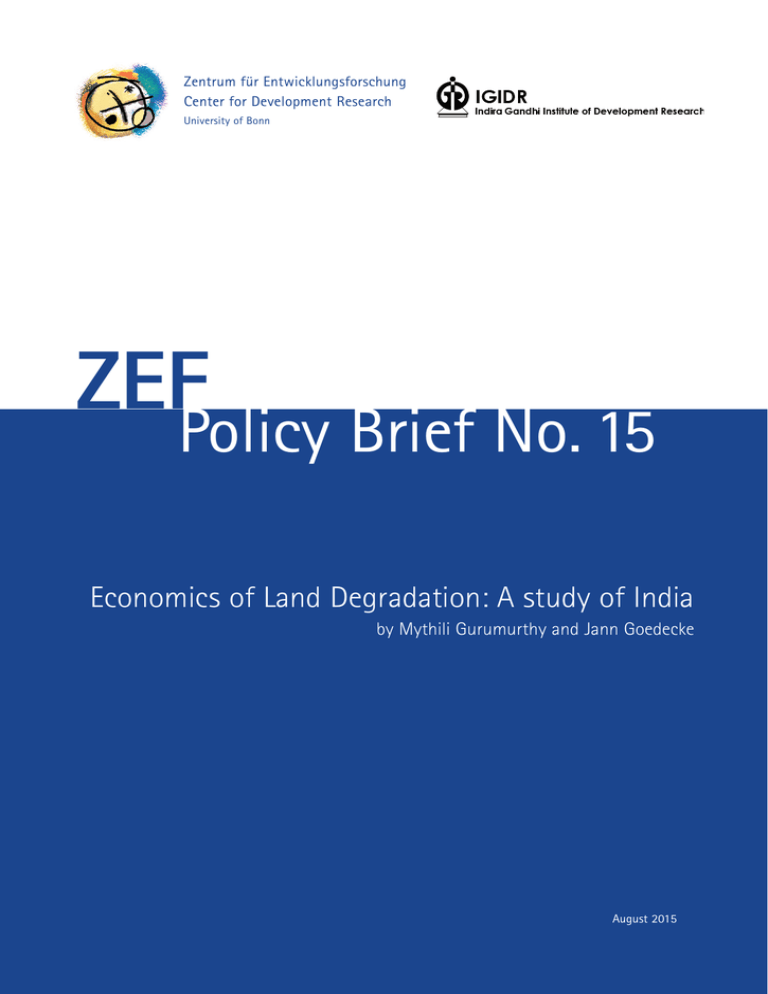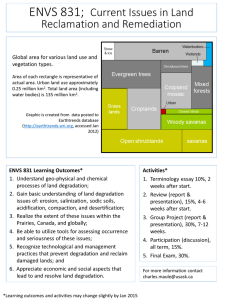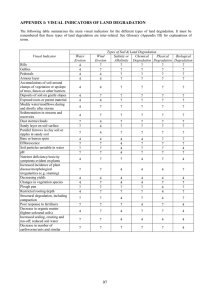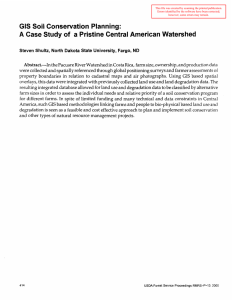ZEF Policy Brief No. 15 by Mythili Gurumurthy and Jann Goedecke
advertisement

Zentrum für Entwicklungsforschung Center for Development Research University of Bonn ZEF Policy Brief No. 15 Economics of Land Degradation: A study of India by Mythili Gurumurthy and Jann Goedecke August 2015 ZEF Policy Brief No. 15 MAIN FINDINGS 1 Two thirds of the Indian population rely on agriculture for their livelihoods. Yet, about 44% of the Indian land area is degraded. 2 Two major factors contribute to land degradation: subsidies for inputs and decreasing land-man ratio. 3 Subsidies for fertilizers contribute to a large extent to land degradation. A 1% reduction in subsidies could reduce degradation by nearly 3%. 4 Agricultural extension services need to be strengthened to raise awareness for conservation technologies. Introduction In India, two thirds of the population depend on agriculture for their livelihoods. Yet, about 44% of India’s land area is degraded due to cultivation of marginal lands, improper crop rotations or deforestation as a consequence of shifting cultivation. Intensive farming, which has been promoted as a result of the Green Revolution, has depleted soil of its nutrients. This has also led to a reduction in agricultural yields. Furthermore, household factors such as poverty, land fragmentation, insecure land tenure and institutional failures are also contributing to land degradation. area (or 119 mln ha), followed by salinity which prevails on irrigated lands. About 50% of canal-irrigated area is affected by salinization and/or alkalization due to poor drainage. Land degradation has been spreading in India since 1980s. Then, an estimated 5 bln tons of soil were lost each year due to erosion1, whereas at the beginning of the 21st century the figures were gauged to range from 6 to 12 mln tons2 of soil, which was mainly being washed out into water bodies. The same trend can be observed regarding land surface: around 3.7 mln ha of land surface were affected by nutrient loss and/or loss of organic matter in the 1990s.3 More recent data, using the Normalized Differenced Vegetation Index (NDVI) have shown a decline in vegetation cover on 47 mln ha (16%) of the Indian territory between 1982-2006, of which 41 mln ha is either cropland or forest land.4 Clear hotspots can be identified: The central region is most affected, with 59% of its land area being degraded, followed by the NorthEast and the South. In recent years it has become evident that an imbalanced Land degradation in India About 60% of land is cultivable in India, of which 80% is used as cropland. Forests make up 25% of the total land area. Since the 1970s, cropland has expanded, but so has urbanization. Erosion due to water and wind is the main cause of degradation on 70% of the total degraded 2 Figure 1. Land degradation hotspots in India. Source: Le et al. 2014 ZEF Policy Brief No. 15 use of fertilizers is a further cause for loss of micronutrients on a large scale. Therefore a need for rationalisation of fertiliser subsidy has been discussed in recent Plan documents. Off-site effects of erosion - A rising demand for food, fodder and fuel drives land degradation. - Intensive cultivation of lands with irrigation, mechanization and High-YieldingVariety (HYV) seeds contribute to land degradation. Off-site effects particularly include the siltation of reservoirs through the deposition of material, especially in Bihar and Uttar Pradesh. The total area affected by siltation is about 2.73 mln ha. Siltation reduces the storage capacity of water bodies and consequently increases the likelihood of floods.5 - High population pressure does not per sé lead to degraded areas6. Methodology - The influence of other socio-economic factors on land degradation in India remains inconclusive. The Total Economic Value Framework was applied, relying on data from the The Economics of Ecosystems and Biodiversity (TEEB) database. In eight villages, discussions with focus groups were held to collect information about the local conditions. In addition, quantitative macro and micro analyses on the drivers of land degradation were conducted, using compiled state-level panel data, and extensive householdlevel panel data from the Comprehensive Cost of Cultivation scheme, respectively. Drivers of land degradation Prior to the Green Revolution in India agricultural production was mainly increased by expanding agricultural lands. This occurred often at the expense of community or forest land and the consequent land cultivation led to soil erosion and degradation. Although the Green Revolution brought about benefits in terms of land saving, capital-intensive methods within the Green Revolution could not reduce pressure on cultivated lands. Our key findings regarding the drivers of land degradation in India include: - Poverty cannot be regarded as reason of degradation. - Application of organic manure lowers the likelihood of erosion, while pesticides are found to increase erosion. - Rainfed and irrigated agricultural lands are equally affected by degradation. - Subsidies for fertlizers are a major cause of land degradation. A 1% reduction in subsidies could reduce degradation by nearly 3%. - Well-working drainage systems prevent losses from water and increase water use efficiency, while they lower the risk of salinization at the same time. Costs of land degradation In 2009, the annual costs of land degradation by changing land use and land cover were estimated to amount to 5.4 bln USD, compared to 2001. The highest costs occurred in the states of Kerala, Rajasthan, Andhra Pradesh, Orissa and Madhya Pradesh. In every state, the costs of inaction exceed the costs of action. On average, the costs of action are less than half the costs of inaction (41%), and regional differences show much lesser costs of inaction in Punjab and Haryana province 3 ZEF Policy Brief No. 15 contributes to degradation. Institutional changes and market-based instruments can help change behavior. For example, correcting the low administered prices for surface irrigation water, power and fertilizer could improve the situation. Agricultural extension services need to be strengthened to raise awareness for conservation technologies. References Figure 2. Annual costs of land degradation. Source: The authors. due to low land use change. Rangeland degradation leads to a loss of 7.7 mln USD in meat and milk production.7 Results from the focus groups Villagers feel that the benefits from restoring degraded sites exceed the costs. Raising community awareness and enacting governmental policies setting appropriate incentives for communities would contribute to ecosystem conservation. In general, the interviews revealed that many villagers are willing to contribute to soil improvement. 1 Singh G, Babu R, Bhushan N, Abrol I.P. (1990). Soil Erosion Rates in India, Journal of Soil and Water Conservation, 47 (1), 97-99. 2 State of the Environment India (2001). Land Degradation, Part III http://envfor.nic.in/sites/ default/files/soer/2001/soer.html. Accessed February 2014. 3 Sehgal J. and Abrol I.P. (1994). Soil Degradation in India: Status and Impact, Oxford and IBH. 4 Le Q.B., Nkonya E. and Mirzabaev A. (2014). Biomass Productivity- based Mapping of Global Land Degradation Hotspots, ZEF Discussion Paper on Development Policy No. 193, Centre for Development Research, University of Bonn. 5 Mukherjee, B.K. Das D.C. Shamsher Singh, Prasad C.S. and Samuel J.C. (1985). Statistics: Soil and water Conservation- watershed management, land resources and land Reclamation- Soil and Water Conservation Division, Ministry of Agriculture and Rural Development, GOI, New Delhi. 6 Reddy, V R. (2003). Land Degradation in India: Extent, Costs and Determinants. Economic and Political Weekly, Vol 38, No. 44, 4700- 4713. 7 Kwon H, Nkonya E, Johnson T, Graw V, Kato E, and E Nyathira. 2015. Global estimates of the impacts of grassland degradation on livestock productivity from 2001 to 2011. Nkonya E, Mirzabaev A, and J. von Braun (eds.). The Economics of Land Degradation and Improvement– A Global Assessment for Sustainable Development. Springer, Dordrecht, Netherlands. Conclusion Understanding the impact of specific drivers is an important step to identify effective policies that help abate land degradation. For example, irrigation in itself balances out degradation, while poor management of irrigation infrastructure increases degradation. Reducing the wastage of water would contribute to solving water logging and salinization. Joint management of forests could help reduce soil erosion through wind and water. Overall, water and energy are underpriced in India which also 4 IMPRINT Publisher: Zentrum für Entwicklungsforschung (ZEF) Center for Development Research Walter-Flex-Strasse 3, 53113 Bonn Germany phone: +49-228-73-1846 e-mail: presse. zef@uni-bonn.de www.zef.de Contact: Alisher Mirzabaev, ZEF, almir@uni-bonn.de Editor: Rebecka Ridder and Alma van der Veen Layout: Katharina Zinn

![Pre-workshop questionnaire for CEDRA Workshop [ ], [ ]](http://s2.studylib.net/store/data/010861335_1-6acdefcd9c672b666e2e207b48b7be0a-300x300.png)




